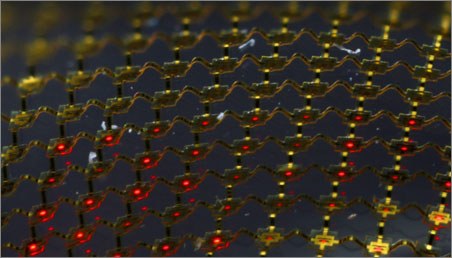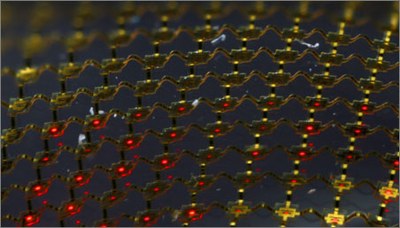Ultrathin LEDs Create New Classes of Lighting and Display Systems
A new process for creating ultrathin, ultrasmall inorganic light-emitting diodes (LEDs) and assembling them into large arrays offers new classes of lighting and display systems with interesting properties, such as see-through construction and mechanical flexibility, that would be impossible to achieve with existing technologies.
Applications for the arrays, which can be printed onto flat or flexible substrates ranging from glass to plastic and rubber, include general illumination, high-resolution home theater displays, wearable health monitors, and biomedical imaging devices.
Rogers and collaborators at the U. of I., Northwestern University, the Institute of High Performance Computing in Singapore, and Tsinghua University in Beijing describe their work in the Aug. 21 issue of the journal Science.
Compared to organic LEDs, inorganic LEDs are brighter, more robust and longer-lived. Organic LEDs, however, are attractive because they can be formed on flexible substrates, in dense, interconnected arrays. The researchers’ new technology combines features of both.
“By printing large arrays of ultrathin, ultrasmall inorganic LEDs and interconnecting them using thin-film processing, we can create general lighting and high-resolution display systems that otherwise could not be built with the conventional ways that inorganic LEDs are made, manipulated and assembled,†Rogers said.
To overcome requirements on device size and thickness associated with conventional wafer dicing, packaging and wire bonding methods, the researchers developed epitaxial growth techniques for creating LEDs with sizes up to 100 times smaller than usual. They also developed printing processes for assembling these devices into arrays on stiff, flexible and stretchable substrates.
As part of the growth process, a sacrificial layer of material is embedded beneath the LEDs. When fabrication is complete, a wet chemical etchent removes this layer, leaving the LEDs undercut from the wafer, but still tethered at anchor points.
To create an array, a rubber stamp contacts the wafer surface at selected points, lifts off the LEDs at those points, and transfers them to the desired substrate.
“The stamping process provides a much faster alternative to the standard robotic ‘pick and place’ process that manipulates inorganic LEDs one at a time,†Rogers said. “The new approach can lift large numbers of small, thin LEDs from the wafer in one step, and then print them onto a substrate in another step.â€
By shifting position and repeating the stamping process, LEDs can be transferred to other locations on the same substrate. In this fashion, large light panels and displays can be crafted from small LEDs made in dense arrays on a single, comparatively small wafer. And, because the LEDs can be placed far apart and still provide sufficient light output, the panels and displays can be nearly transparent. The thin device geometries allow the use of thin-film processing methods, rather than wire bonding, for interconnects.
In addition to solid-state lighting, instrument panels and display systems, flexible and even stretchable sheets of printed LEDs can be achieved, with potential use in the health-care industry.
“Wrapping a stretchable sheet of tiny LEDs around the human body offers interesting opportunities in biomedicine and biotechnology,†Rogers said, “including applications in health monitoring, diagnostics and imaging.â€
The work relied critically on broad, collaborative efforts at the U. of I. In addition to Rogers, the efforts included electrical and computer engineering professors Xiuling Li, an expert in epitaxial growth, and Kent Choquette, a leader in semiconductor optoelectronics. Mechanical science and engineering professor Placid Ferreira developed the printing-based manufacturing tools.
Theoretical collaborators at Northwestern University, led by professor Younggang Huang, and at Tsinghua University, under the guidance of Younggang’s father, professor Keh-chih Hwang, supported the project through calculations of mechanical strains in the flexible and stretchable systems. Researchers at the Institute for High Performance Computing in Singapore provided finite-element studies of the same systems.
“This sort of broadly interdisciplinary, integrated effort was essential for a successful outcome,†Rogers said. “It would be extremely difficult to replicate this type of project at any place other than at the U. of I.â€
Rogers is affiliated with the Beckman Institute, the department of mechanical science and engineering, the Frederick Seitz Materials Research Laboratory, and the Micro and Nanotechnology Laboratory.
Ford Motor Co., the National Science Foundation and the U. S. Department of Energy funded the work.


